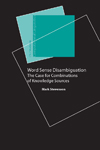

|
|
|
|

Word Sense DisambiguationCombining Knowledge Sources for Sense Resolution The word 'bat' can denote a nocturnal animal, a sports apparatus, the blink of an eye, and other interpretations. Humans seem to effortlessly select the appropriate meaning when hearing such an ambiguous word. But computer applications notoriously fail more often than succeed in performing what is known as Word Sense Disambiguation (WSD). Increasingly familiar examples are found in keyword searches over the internet and in translation between human languages. However, the problem of WSD is not new. It has been intensively studied in the last decade within academic papers and meetings, but no dedicated books such as this one has ever been devoted to the subject. This book provides descriptions of novel research as well an overview of the field of WSD, with accounts of previous approaches and methodological issues. The work described here is in fact closely related to the field of lexicography—the process of creating dictionaries. The author presents a description and an evaluation of a practical computer system that has been found to produce extremely accurate word-disambiguation decisions in English. Among the information utilized by this system is the grammatical behaviors of words, the topics of the texts in which they are used, and definitions found in the dictionary. A central thesis of this book is that, while the combination of these knowledge sources is more effective than any one used alone, these sources are, to some degree, independent. Contents
7/1/2002 ISBN (Paperback): 1575863901 (9781575863900)
|
Distributed by the
University of Chicago Press |
|
pubs @ csli.stanford.edu
|
CSLI Publications
Stanford University Cordura Hall 210 Panama Street Stanford, CA 94305-4101 (650) 723-1839 |